The Flu Isn't a Cold: A Brief User's Guide to Terrible, Seasonal Diseases
With the holidays upon us, you are far from safe from infection.

Cases of the flu and cold amp up during the winter season. The generally terrible way we treat our bodies during the holidays doesn’t help. But all illnesses are not created equal and the flu and the common cold are two very different beasts. The former changes annually, while the latter just continues to do its miserable thing.
The Flu:
Flu outbreaks in the Northern hemisphere usually happen as early as October and simmer down in late May. Peak of infection usually happens in February, while the CDC says that right now flu season is “just getting started,” making this the appropriate moment to sound the hype for the worst party ever. The vaccination for the flu takes about two weeks to actually get to work, so the CDC warns that if you are unvaccinated and think you might as well not get the shot now — you’re wrong.
There are two flu vaccines available in the United States this year — a trivalent vaccine that gives protection against three kinds of viruses and a quadrivalent that protects against four. This vaccine protects against two B-strand viruses and two A-strand viruses — H3n2 and H1N1 otherwise known as swine flu, otherwise known as what ruined my 2009 Christmas.
Flu activity spikes in December but hits hardest in February.
What vaccine you’ll get is determined by whatever strands are going around in your region. Seasonal flu vaccines are updated every year depending on what strands are out there, how they’re spreading, and how well current vaccine components are doing protecting people. The vaccines this year are expected to be extra strong — mostly because last year’s vaccines were only about 19 percent effective against a “moderately severe” flu season. However, the effectiveness of vaccines is never a guaranteed thing.
Different flu viruses die out after a few years circulating the globe — and they are quickly replaced by new strands. No matter what, people with the flu are likely to experience symptoms like fever, body aches, extreme tiredness, and a dry cough.
The Common Cold:
While brethren in respiratory illnesses, the common cold and the flu are caused by different viruses. And unlike the flu, cold viruses are almost always present in the environment. They last for about a week and people are likely to have two to three colds per year.
Colds can be caused by more than 100 different viruses but are connected to rhinoviruses. Antibiotics cannot cure the common cold — actually, so far doctors think nothing cures the common cold. You’re just stuck with it. All cold medicines can do is mask your symptoms.
Colds are accompanied by a sore throat and cough.
Despite the misleading name of “cold”, colds are not affected by a direct link to temperature. But they are indirectly affected by the weather — colds are most likely to happen when people are inside, cooped up together. You get colds when someone with a cold touches their nose or eyes, and then gets their grimy hands on something you later touch. They are also transmitted through the air when someone coughs or sneezes.
Stress increases your risk of catching a cold as does being generally terrible to your body: not exercising, not eating enough fruits and vegetables, not resting. Basically everything that happens when you get ready for the holidays. The best way to get over a cold is to chill out and eat well.
Take comfort in the fact that kids are more likely to get both the flu and the common cold — you’re doing better than the youth! But then when you’re officially “elderly” your likelihood of getting ill goes up again. Need a tissue?